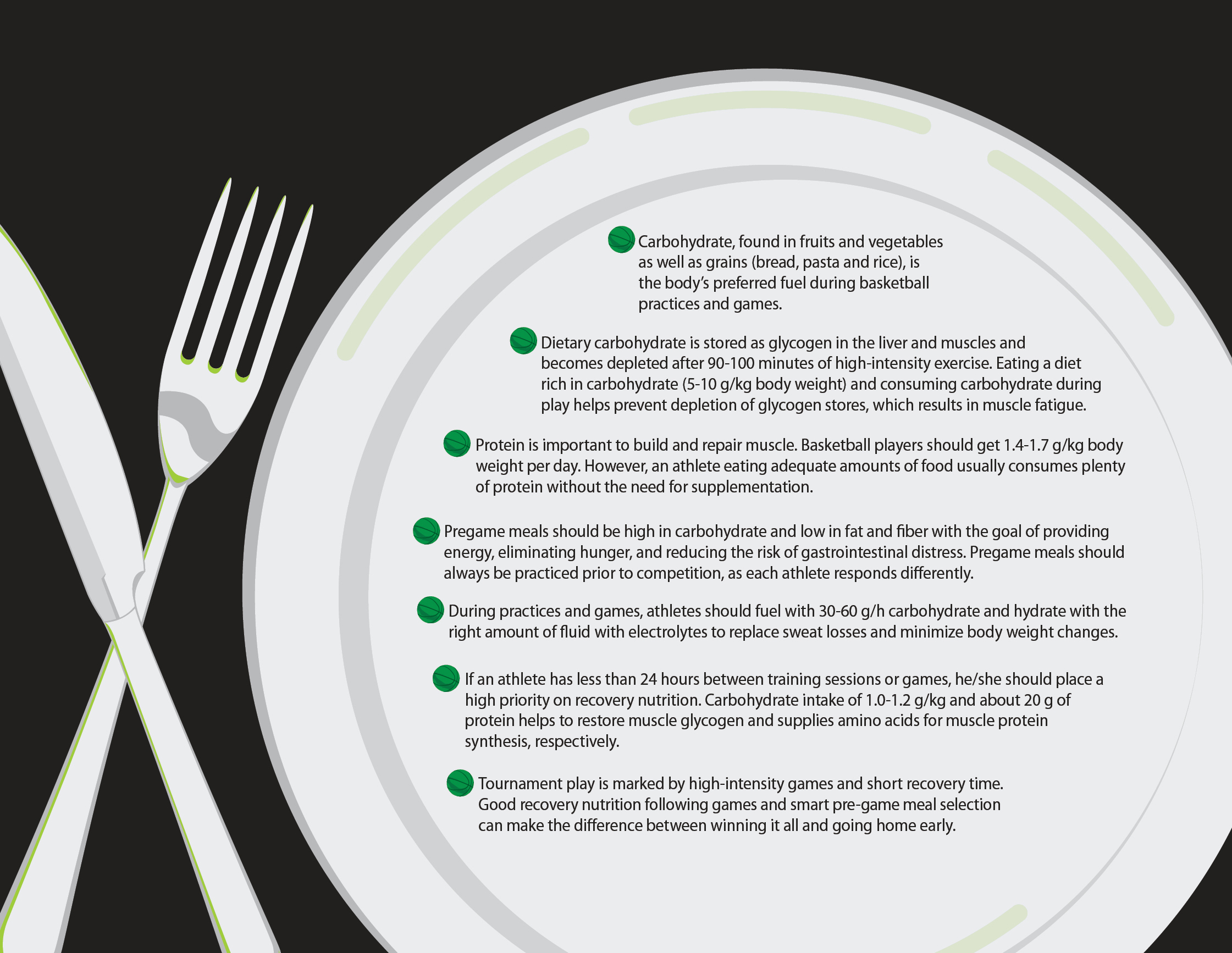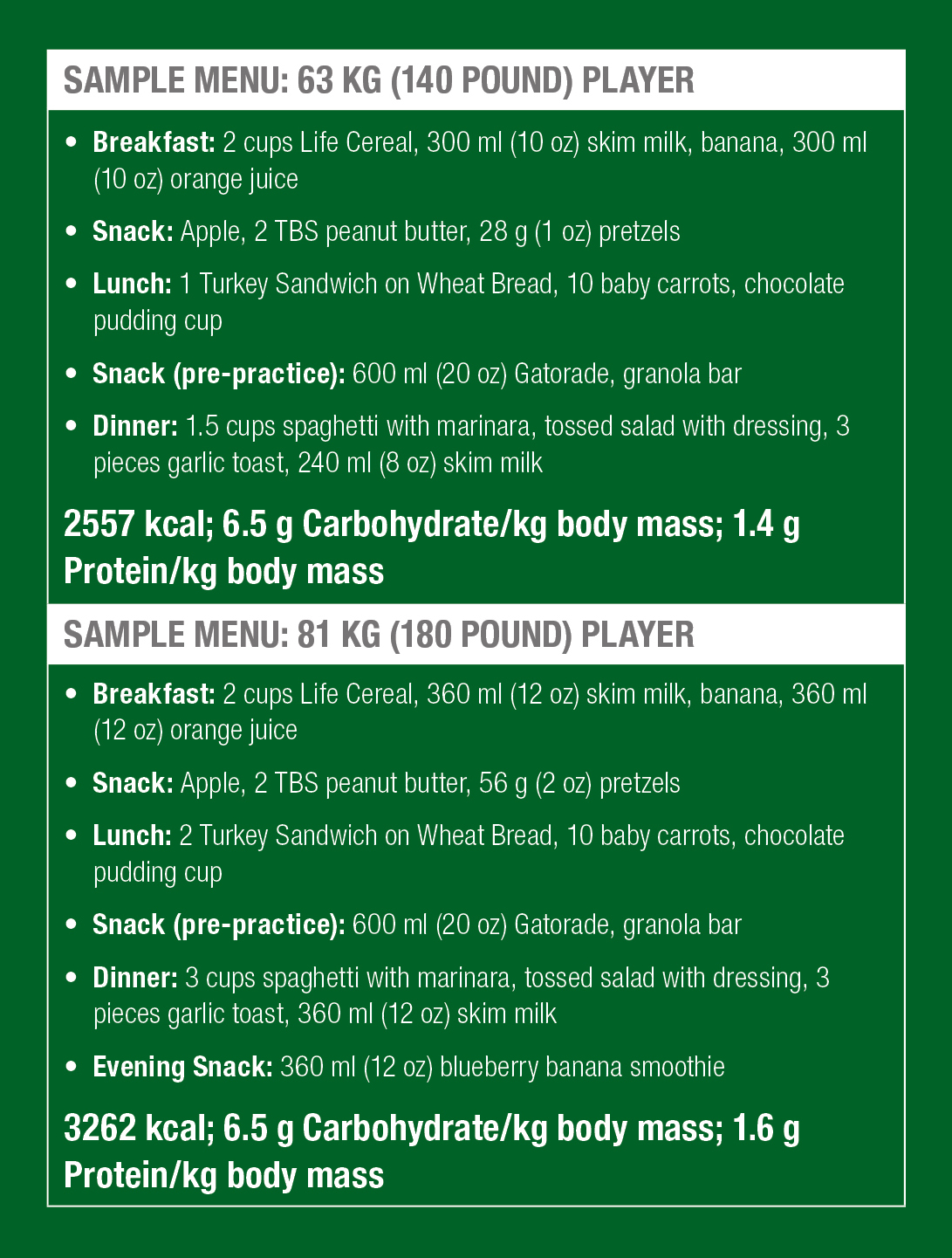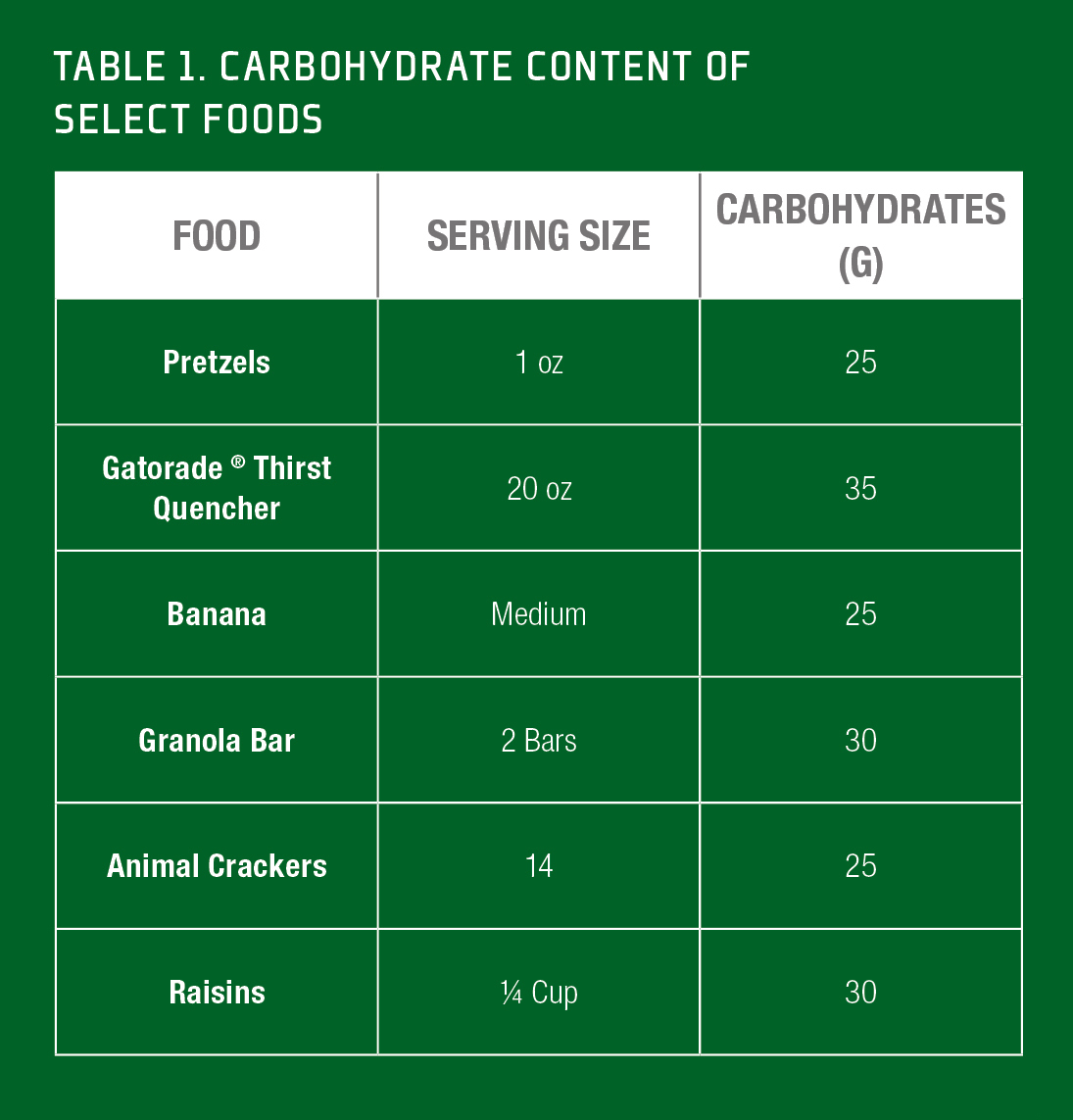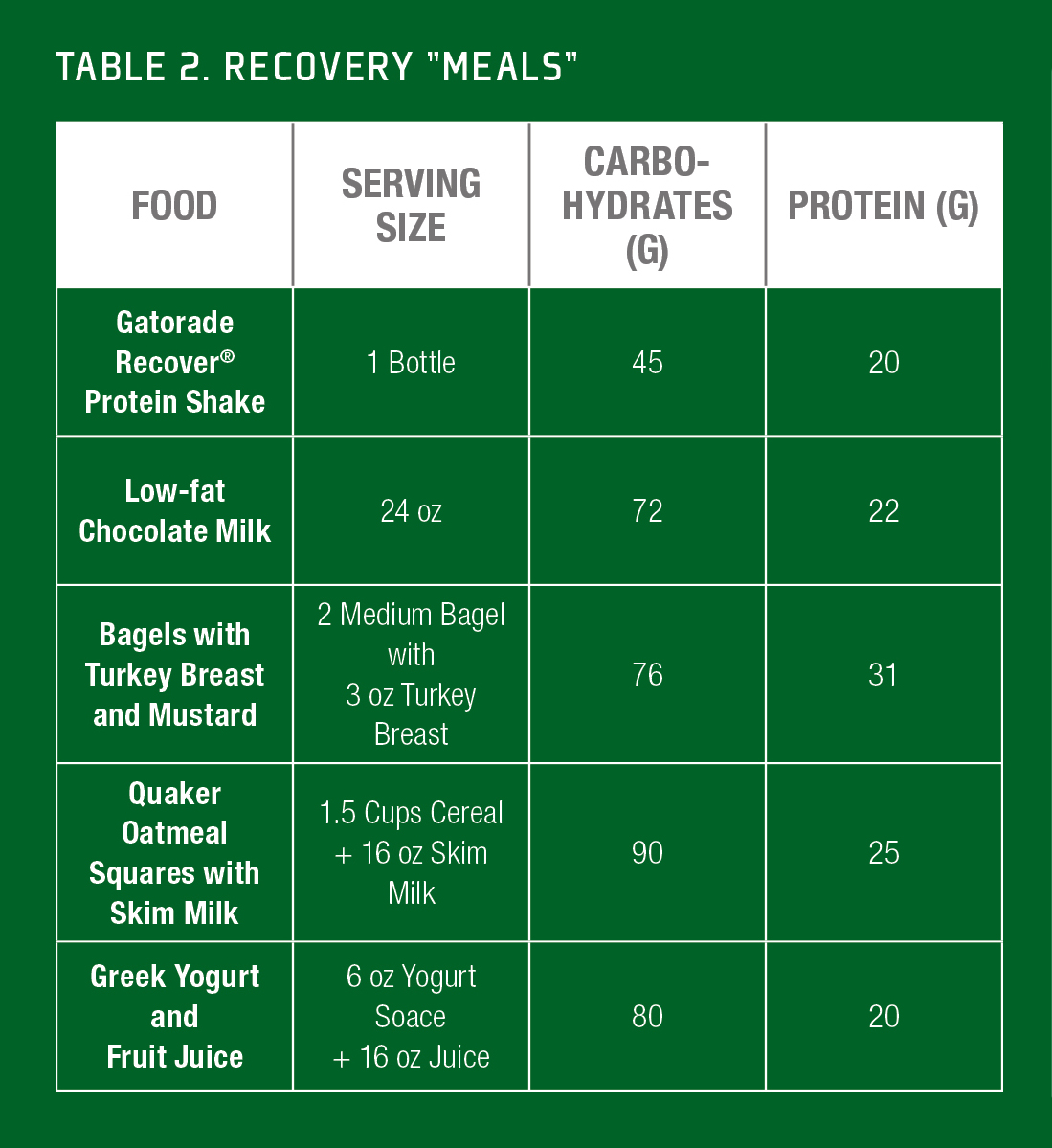INTRODUCTION
Basketball is an intermittent, high-intensity sport requiring both physical agility and mental acuity. Energy demands during the basketball season are substantial and may be even higher during off-season training.
Choosing foods that will provide the energy to support competition and training is essential and can also be quite challenging. Unlike high-level college or professional basketball players who have the means and opportunity to eat a proper diet, smaller-school college players and high school athletes have variable access to resources. This chapter will focus on the principles of fuel selection in a variety of situations with the goal of accommodating all players.
KEY FINDINGS

DAILY ENERGY NEEDS
The energy requirements of high-school basketball players can be considerable. In a recent study by Silva et al,4 energy expenditure in elite high-school-aged female and male basketball players during the season was measured to be over 3,500 and 4,600 kcals/day, respectively. Although total energy intake is important to counteract weight loss during the season, the source of the calories is critical to provide the muscle with the right type of fuel.
CARBOHYDRATE
The muscle’s preferred fuel during high-intensity activities such as basketball is carbohydrate. The body stores carbohydrate as glycogen in the liver and skeletal muscle. Carbohydrate stored in the liver maintains blood glucose between meals. The liver stores between 75–100 g of carbohydrate, enough to maintain blood glucose during a 12-hour fast. Most people have used up the majority of their liver glycogen by the time they awaken in the morning, which is why it’s so important for athletes to eat before a morning practice. Skeletal muscle stores an additional 300–400 g of carbohydrate. Unlike liver glycogen, the muscle uses its supply of carbohydrate to fuel exercise, and training can nearly double the amount of glycogen the muscle can store.3 This is advantageous because the more glycogen in the muscle, the longer an athlete can sprint, jump, and run. When muscle glycogen stores are full, most athletes have enough to fuel 90–100 minutes of high-intensity activity. Terms such as “hitting the wall” or “bonking” are used to describe the phenomenon that happens when an athlete’s glycogen stores run low. While individual practices and games may not be enough to deplete muscle glycogen, inadequate carbohydrate intake coupled with daily training can deplete muscle glycogen over the course of several days. This leaves a player fatigued or with a feeling of “heavy legs.”
Basketball players should consume a high-carbohydrate diet; that is to say that at least 55% of total calories in the diet should come from food rich in carbohydrate such as fruits, vegetables, bread, pasta, and rice. Most sports dietitians recommend carbohydrate intake based on body mass to ensure an athlete consumes adequate energy from carbohydrate. The range of carbohydrate intake suggested for basketball players is 5–7 (and up to 10) g/kg body weight (see sample diet below). The amount will vary depending upon playing time and the time of year (preseason, in-season, or postseason).
PROTEIN
Protein is important for building and maintaining lean body mass. Although many athletes take supplements and make efforts to increase dietary protein to build muscle mass, this is usually unnecessary if they are eating a well-balanced diet with sufficient energy and protein intake spaced throughout the day. Research shows that protein intake of 1.8 g/kg body weight is the upper limit for muscle protein synthesis.2 For a 63 kg (140 lb) player, that’s about 115 g of protein. A player that weighs 82 kg (180 lb) may need up to 150 g. As shown in the sample menu, this is easily met with adequate energy intake. While eating protein above this amount is not harmful for healthy people, it often displaces energy from carbohydrate in the diet, which, as discussed above, is the muscle’s preferred fuel. While the muscles will utilize protein when carbohydrate is low, this is an inefficient metabolic process and will leave the athlete feeling run down and fatigued. The recommendation for daily protein intake for basketball players is 1.4–1.7 g/kg of body mass.
FAT
Dietary fats are important for the synthesis of hormones and cell membranes, as well as proper immune function. Athletes should strive to eat heart-healthy fats such as mono-unsaturated fats (olive oil, avocado) as well as omega-3 fats (salmon, flaxseed) and avoid saturated fats (beef fat, lard) and trans fats (margarine and processed foods). Energy intake from fat should make up the remainder of calories after protein and carbohydrate recommendations are met.

PREGAME MEALS
The goal for any pre-competition meal is to help with the body’s energy needs (e.g., top off liver glycogen) while eliminating the distraction of hunger and reducing the risk of gastrointestinal problems. Appropriate meals or foods should be high in carbohydrate, low in fat, and low in fiber (See Table 1). A good rule of thumb for carbohydrate is the following equation:
(body weight in kilograms) x (hours prior to competition) = grams of carbohydrate

For example, a player weighing 68 kg (150 lb) and eating 3 hours prior to the game could eat: 68 kg x 3 hours = 204 grams of carbohydrate This would be equivalent to a small meal including a turkey sandwich, an ounce of pretzels, a granola bar, and 1 L (33 oz) of Gatorade ® Thirst Quencher. On the other hand, if this player is eating 1 hour prior to the game, only about 70 g of carbohydrate should be consumed. An appropriate snack may be 1 liter (33 oz) of Gatorade ® Thirst Quencher and an ounce of pretzels. It is very important that each player find what foods and beverages work best for her or him by experimenting before and during practices. Each person is a bit different, and one player’s “lucky” meal may leave her teammate with stomach cramps.
FUELING DURING GAMES
Basketball games last 32–48 minutes of total playing time, depending on the level. Although it is unlikely that a player will drain his muscle and liver glycogen stores, supplementing with carbohydrate during the game may help maintain performance in the fourth quarter. Research shows that both cognitive function5 and sprint speed1 are maintained in basketball-type protocols when subjects are supplemented with carbohydrate rather than a placebo. Again, players should experiment during practices to find what foods and beverages work best for them; however, Gatorade ® Thirst Quencher, sports gels or chews, portions of sports bars, or oranges have been used by many. The recommended amount of carbohydrate to consume to maintain performance is 30–60 g/h. Therefore, given the game duration, an athlete should find the best solution to take in 30–60 g of carbohydrate over the course of a game. Using Gatorade ® Thirst Quencher, for example, 16–32 oz will meet the carbohydrate needs and provide fluid and electrolytes.
Importantly, all forms of carbohydrate supplementation should also include fluid replacement, as dehydration is detrimental to basketball performance. Fortunately, basketball lends itself to natural breaks in the action. Time-outs, breaks between quarters, and halftime are opportunities for players to refuel and rehydrate. As mentioned previously, consuming foods or fluids should be practiced during training to determine the most effective strategy. To determine an individual’s sweat rate, weigh your players before and after a practice session in the same clothing, after toweling off excess sweat. If they lost weight, they didn’t drink enough fluid and should consume an additional 16 oz per pound of body weight lost in the next practice. Each player should aim to lose < 2% body weight during practices and games (e.g., 3 lbs, for a 150-lb, player), and the amount that each player will need to maintain hydration will be different. Likewise, each player may prefer and tolerate different forms of carbohydrate. Players should be encouraged to find the combination of foods and fluids that works best to maintain hydration and energy while reducing the risk of stomach cramps.
RECOVERY
Recovery nutrition is very important when players have less than 24 hours between games or training sessions. In the 30–60 minutes immediately following exercise, the muscles used during exercise are especially sensitive to amino acids and glucose in the blood and are able to use them for muscle protein synthesis and glycogen restoration, respectively. Eating a meal or drinking a recovery shake during this “window” of time allows the muscle to recover its glycogen stores much more quickly than the same meal eaten 2 or 3 hours after exercise. Recommended carbohydrate intake is 1.0–1.2 g of carbohydrate/kg body weight and about 20 g protein. For a 68 kg (150-lb.) person, this would be about 82 g carbohydrate (328 kcal). Some players prefer liquid meals for recovery, as they may not have an appetite following competition. Many commercial recovery products are available; however, chocolate milk and other foods are also appropriate (See Table 2). Although it is important to consume carbohydrate and protein during the time immediately following competition, players should make a point of eating a well-balanced meal within 2 hours to give the muscles another “dose” of fuel. Athletes should also rehydrate after practices and games with about 20–24 oz, of fluid, preferably with sodium, for every pound of body weight lost.
TOURNAMENT PLAY
The principles of pregame meals and recovery should be followed for teams entering tournament play. Most basketball teams participating in tournament play will not play more than one game per day; however, they may play back-to-back games with less than 24 hours to recover. In this scenario, it becomes essential that players are provided with foods that supply carbohydrate to restore their muscle glycogen reserves, protein to help with muscle protein synthesis, and fluid to rehydrate. Table 2 provides examples of foods that can help kick-start recovery. Teams that must play more than one game per day or play in the evening and again in the morning should consume pregame meals that are high in carbohydrate, low in fat, and low in fiber. Breakfasts may include toast or bagels with jam, a small stack of pancakes with syrup, or ready-to-eat cereal with skim milk. Lunches or dinners may consist of pasta with marinara sauce, a low-fat sandwich or wrap, or soup with bread. Again, the goal of a pregame meal is to provide energy without causing gastrointestinal distress.

SUMMARY
Developing the skills needed to become a great basketball player requires endless hours of time spent shooting, passing, ball-handling, and conditioning. Ignoring proper nutrition is like building a high- performance sports car and putting the wrong gas in the tank; it cannot operate optimally unless its engine is given high-grade fuel. Such is the case with athletes. Although the body can function on “junk food,” it will not perform as well as it could when given the proper types of food in the correct amounts at the optimal times. Eating a variety of whole grains, fruits and vegetables, lean sources of protein, and healthy fats will provide high-quality fuel for the best possible performance.
REFERENCES
-
Patterson, S.D. and S.C. Gray (2007). Carbohydrate-gel supplementation and endurance performance during intermittent high-intensity shuttle running. Int. J. Sport Nutr. Exerc. Metab. 17:445-455.
-
Phillips S.M. and L.J. Van Loon (2011). Dietary protein for athletes: from requirements to optimum adaptation. J. Sports Sci. 29 Suppl:S29-38.
-
Roedde, S., J.D. MacDougall, J.R. Sutton, and H.J. Green (1986). Supercompensation of muscle glycogen in trained and untrained subjects. Can. J. Appl. Sport Sci. 11:42-46.
-
Silva, A.M., D.A. Santos, C.N. Matias, C.S. Minderico, D.A. Schoeller, and L.B. Sardinha (2012). Total Energy Expenditure Assessment in Elite Junior basketball Players: A validation study using double labeled water. J. Strength Cond. Res. 27:1920-1927.
-
Winnick, J.J., J.M. Davis, R.S. Welsh, M.D. Carmichael, E.A. Murphy, and J.A. Blackmon (2005). Carbohydrate feedings during team sport exercise preserve physical and CNS function. Med. Sci. Sports Exerc. 37:306-315.